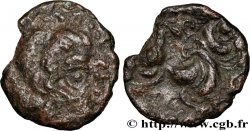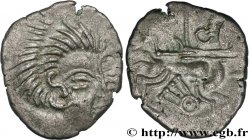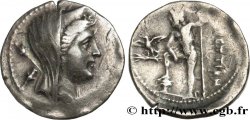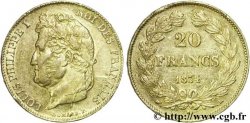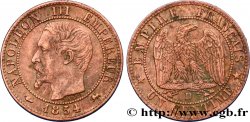v43_1155 - GALLIA - ARMORICA - CORIOSOLITÆ (Regione di Corseul, Cotes d'Armor) Statère de billon, classe VI, hybride vénèto-coriosolite
MONNAIES 43 (2010)
Начальная цена : 220.00 €
Назначить цену : 450.00 €
Цена реализации : 220.00 €
Начальная цена : 220.00 €
Назначить цену : 450.00 €
Цена реализации : 220.00 €
Тип Statère de billon, classe VI, hybride vénèto-coriosolite
Дата: c. 80-50 AC.
Монетный двор / Город: Saint-Brieuc (22)
Металл: billon
Диаметр: 21 mm
Ориентация осей монеты: 8 h.
Вес: 4,24 g.
Редкость: R3
Комментарии о состоянии
Statère frappé sur un flan un peu court, avec une usure marquée mais bien identifiable des deux côtés. Aspect poreux typique du billon et patine grise avec un coup de burin vertical au revers
Ссылки в каталоге: :
Лицевая сторона
Аверс: легенда: ANÉPIGRAPHE.
Аверс: описание: Tête humaine à droite, chevelure en deux rouleaux, les cheveux divisés en grosses mèches en forme de S, le nez réaliste, l’œil ovale.
Обратная сторона
Реверс: легенда: ANÉPIGRAPHE.
Реверс: Описание: Cheval androcéphale bridé, galopant à gauche ; au-dessus, restes de la tête de l'aurige et hampe pointée ; entre les jambes, un sanglier.
Комментарий
Le revers avec le cheval et le sanglier orientés à gauche rappelle les classes III et IV des Vénètes. Le type de droit se rapporterait à la classe IIIb. Mais le métal utilisé et le style font plutôt pencher pour une attribution aux Coriosolites. Ce type est rarissime et pourrait constituer une tête de série ou un prototype de la classe VI des Coriosolites qui serait le premier à avoir été frappé. Paradoxalement, avec cet exemplaire et celui de MONNAIES XIX, la métrologie est plutôt faible pour une frappe initiale (?), bien que l'usure soit importante. Le DT. 2331 est quand à lui particulièrement lourd avec 6,71 grammes.
L'exemplaire n° 466 de MONNAIES XIX, le seul autre que nous ayons eu, n'a été vendu qu'à 220€, avec un seul ordre à ... 1000€ !.
The reverse with the horse and boar facing left recalls classes III and IV of the Veneti. The obverse type would relate to class IIIb. But the metal used and the style rather lean towards an attribution to the Coriosolites. This type is extremely rare and could constitute a head of series or a prototype of class VI of the Coriosolites which would be the first to have been struck. Paradoxically, with this example and that of MONNAIES XIX, the metrology is rather weak for an initial strike (?), although the wear is significant. DT. 2331 is particularly heavy at 6.71 grams. Example no. 466 of MONNAIES XIX, the only other one we have, was sold for only €220, with a single order at... €1000!
L'exemplaire n° 466 de MONNAIES XIX, le seul autre que nous ayons eu, n'a été vendu qu'à 220€, avec un seul ordre à ... 1000€ !.
The reverse with the horse and boar facing left recalls classes III and IV of the Veneti. The obverse type would relate to class IIIb. But the metal used and the style rather lean towards an attribution to the Coriosolites. This type is extremely rare and could constitute a head of series or a prototype of class VI of the Coriosolites which would be the first to have been struck. Paradoxically, with this example and that of MONNAIES XIX, the metrology is rather weak for an initial strike (?), although the wear is significant. DT. 2331 is particularly heavy at 6.71 grams. Example no. 466 of MONNAIES XIX, the only other one we have, was sold for only €220, with a single order at... €1000!








 Cообщить об ошибке
Cообщить об ошибке Распечатать страницу
Распечатать страницу Отправить мой выбор
Отправить мой выбор Задать вопрос
Задать вопрос Consign / sell
Consign / sell
 Информация
Информация


